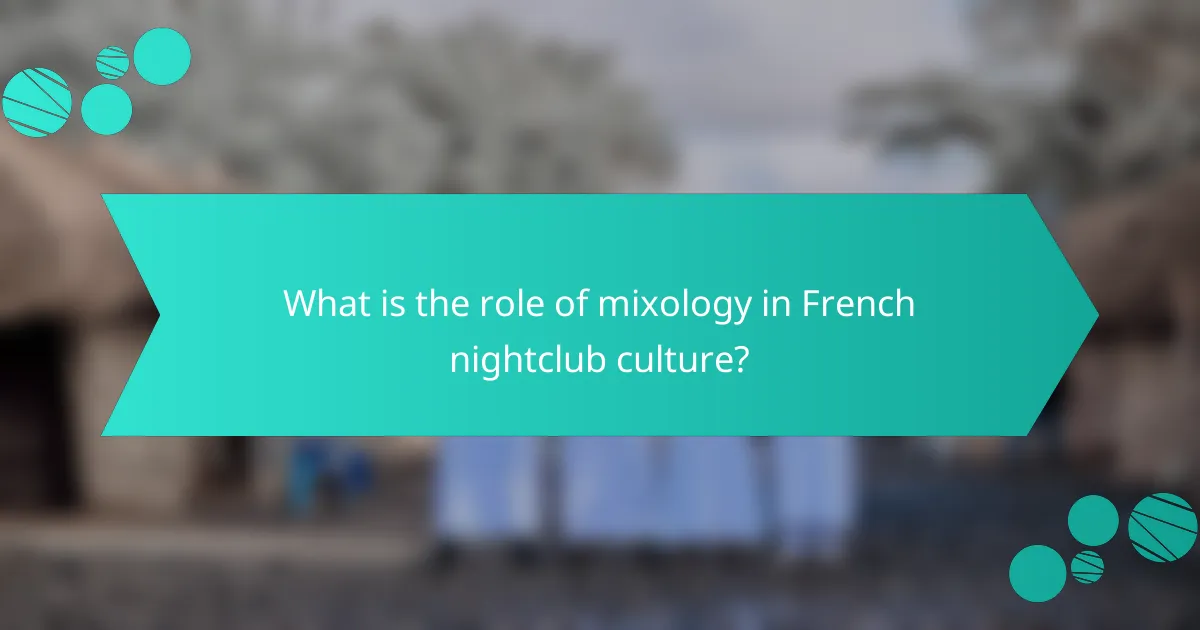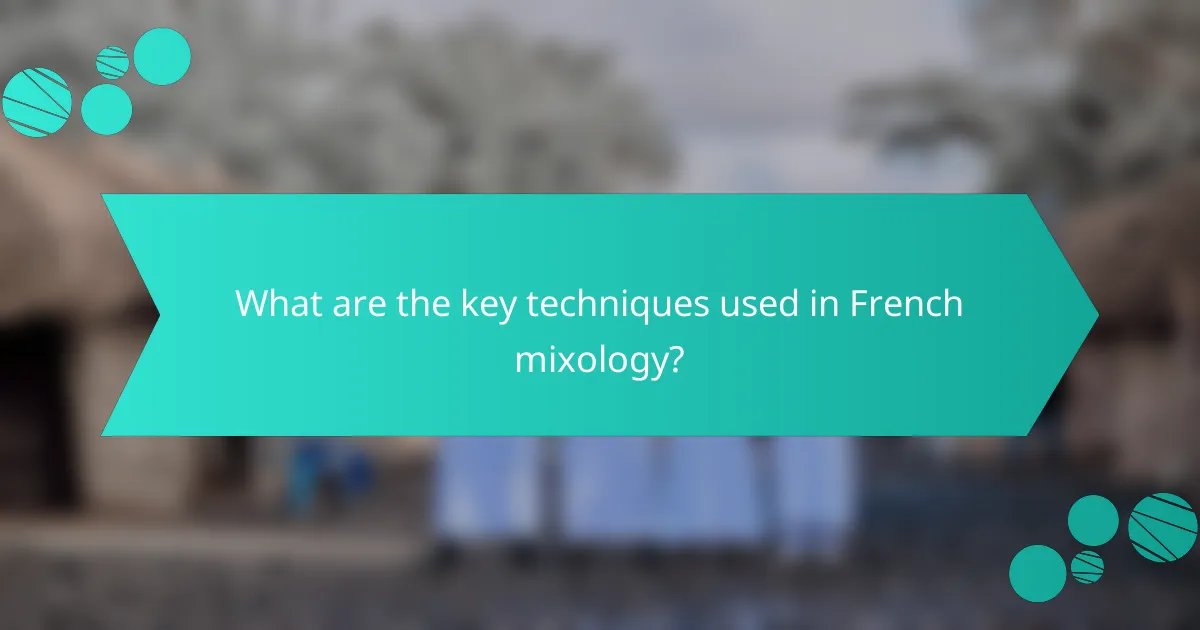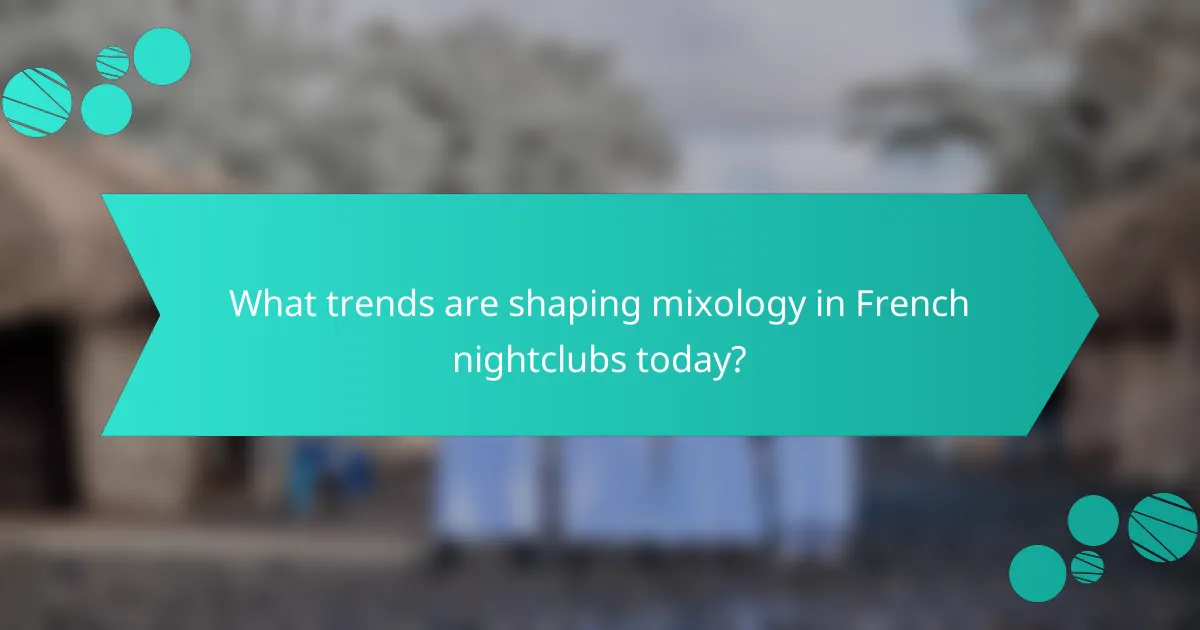Mixology is a vital component of French nightclub culture, enhancing the nightlife experience through the art of cocktail preparation. Expert mixologists create innovative drinks that reflect cultural sophistication, often incorporating local ingredients to showcase regional flavors. Key techniques in French mixology include layering, muddling, shaking, and stirring, all of which contribute to the visual appeal and taste of cocktails. Recent trends emphasize sustainability, with a focus on organic and locally sourced ingredients, as well as a revival of classic cocktails with modern interpretations. This article explores the significance of mixology in French nightclubs, highlighting techniques, current trends, and signature drinks that define this dynamic scene.

What is the role of mixology in French nightclub culture?
Mixology plays a central role in French nightclub culture. It enhances the overall nightlife experience through skillful cocktail preparation. Expert mixologists create innovative drinks that appeal to patrons. This creativity reflects the cultural sophistication associated with French nightlife. Signature cocktails often incorporate local ingredients, showcasing regional flavors. The presentation of drinks is also crucial, as aesthetics attract customers. Mixologists often engage with guests, adding a personal touch to the experience. The rise of craft cocktails in recent years has further elevated the status of mixology in these venues.
How has mixology evolved within French nightlife?
Mixology in French nightlife has evolved significantly over the past few decades. Initially, it focused on classic cocktails and traditional recipes. The rise of craft cocktails in the early 2000s introduced innovative techniques and unique flavor combinations. Bartenders began emphasizing quality ingredients and artisanal spirits. This shift led to the emergence of signature drinks that reflect local culture and trends. Additionally, the influence of global cocktail movements has diversified drink offerings in French nightclubs. Today, mixology is considered an art form, with bartenders showcasing creativity and skill. This evolution has transformed nightlife experiences, making cocktails a central aspect of social gatherings.
What historical influences shaped the art of mixology in France?
The art of mixology in France has been shaped by several historical influences. The French Revolution in the late 18th century led to the democratization of drinking culture. This period saw the rise of bistros and cafés, where cocktails became popular. The introduction of bitters and various spirits from the colonies expanded flavor profiles. The 19th century brought the publication of cocktail books, such as “The Bartender’s Guide” by Jerry Thomas, which influenced French bartenders. The emergence of the Art Deco movement in the 1920s also played a role, promoting stylish and elaborate drinks. Additionally, the influence of American Prohibition led to an influx of American bartenders in France, further refining mixology techniques. These historical events collectively contributed to the evolution of mixology as a sophisticated art form in French culture.
How do cultural elements impact mixology practices in French nightclubs?
Cultural elements significantly influence mixology practices in French nightclubs. The French emphasis on gastronomy shapes cocktail ingredients and presentation. Mixologists often incorporate local flavors, such as herbs and fruits, reflecting regional culinary traditions. French nightlife culture values aesthetic appeal, leading to visually stunning drinks. The influence of Parisian café culture encourages the use of classic cocktails and innovative twists. Additionally, social norms around drinking impact the choice of spirits and mixers. Seasonal events and holidays inspire themed cocktails, integrating cultural celebrations into the drink menu. Overall, these cultural factors create a unique mixology landscape in French nightclubs.
Why is mixology considered an essential aspect of nightclub experiences?
Mixology is considered an essential aspect of nightclub experiences because it enhances the overall ambiance and customer satisfaction. Skilled mixologists create unique and visually appealing cocktails that attract patrons. The art of mixology involves creativity and technique, which elevates the drinking experience. Additionally, signature drinks often reflect the nightclub’s theme, contributing to its identity. Research indicates that 75% of nightlife customers prefer establishments with innovative drink options. This preference drives higher customer retention and spending. Mixology also encourages social interaction, as patrons often share their experiences and recommendations. Overall, mixology plays a crucial role in defining the nightlife experience.
What role does mixology play in enhancing customer satisfaction?
Mixology plays a crucial role in enhancing customer satisfaction by creating unique and personalized drink experiences. Skilled mixologists craft cocktails that appeal to diverse tastes and preferences. This artistry elevates the drinking experience beyond mere consumption. The use of quality ingredients and innovative techniques results in visually appealing and flavorful drinks. Customers are more likely to enjoy their time when presented with thoughtfully prepared beverages. Research shows that 70% of patrons prefer establishments that offer signature cocktails. This preference indicates that mixology significantly contributes to overall enjoyment and satisfaction in nightlife settings.
How does mixology contribute to the overall ambiance of nightclubs?
Mixology enhances the overall ambiance of nightclubs by creating unique and visually appealing drinks. These crafted beverages often reflect the theme and style of the venue. The artistry involved in mixology captivates patrons, drawing them into the nightclub experience. Engaging bartenders showcase their skills, adding to the entertainment factor. Innovative drinks can stimulate social interactions among guests. Additionally, signature cocktails often become a hallmark of a nightclub’s identity. The presentation of drinks, including garnishes and glassware, contributes to the visual atmosphere. Overall, mixology plays a vital role in shaping the sensory experience of nightlife.

What are the key techniques used in French mixology?
The key techniques used in French mixology include layering, muddling, and shaking. Layering involves carefully pouring liquids of different densities to create visually appealing drinks. Muddling is the process of crushing ingredients, such as herbs or fruits, to release their flavors. Shaking combines ingredients with ice to chill and mix them effectively. French mixologists often employ the technique of stirring for cocktails that require a smoother texture. Garnishing is also essential, adding visual appeal and aromatic elements to the drink. These techniques enhance the overall experience and presentation of cocktails in French nightlife.
What are the foundational skills every mixologist should master?
A mixologist should master several foundational skills. These include knowledge of spirits, liqueurs, and mixers. Understanding flavor profiles is crucial for creating balanced cocktails. Mastery of various mixing techniques is essential, such as shaking, stirring, and muddling. Precision in measuring ingredients ensures consistent quality. Customer service skills enhance the overall experience for patrons. Lastly, creativity in cocktail development sets a mixologist apart in the competitive nightlife scene. These skills are vital for success in the dynamic environment of French nightclubs.
How do techniques like muddling and shaking affect drink preparation?
Muddling and shaking are essential techniques in drink preparation. Muddling involves crushing ingredients to release their flavors. This technique is crucial for cocktails like mojitos or old fashioneds. Shaking combines ingredients with ice to chill and dilute the drink. It also aerates the mixture, enhancing texture and flavor. Research indicates that shaking can increase the drink’s perceived freshness. Both techniques contribute to the overall taste and presentation of cocktails. Proper execution of these methods is vital in mixology, especially in vibrant settings like French nightclubs.
What tools are essential for effective mixology in nightclubs?
Essential tools for effective mixology in nightclubs include shakers, jiggers, and strainers. Shakers are crucial for mixing ingredients thoroughly. They come in various types, such as Boston and cobbler shakers. Jiggers allow bartenders to measure precise amounts of spirits and mixers. Accurate measurements ensure consistent drink quality. Strainers separate liquid from solids, providing a smooth pour. Other important tools are muddlers for crushing ingredients and bar spoons for stirring. Each tool enhances efficiency and drink presentation. These tools are standard in professional bars and nightclubs worldwide.
How do mixologists create unique flavor profiles?
Mixologists create unique flavor profiles by combining various ingredients and techniques. They experiment with different spirits, bitters, and mixers to develop distinct tastes. Infusions and homemade syrups enhance complexity. Seasonal fruits and herbs add freshness. Techniques like muddling and shaking incorporate flavors effectively. They also consider balance, ensuring sweet, sour, and bitter elements complement each other. The use of garnishes provides visual appeal and aromatic enhancement. By continuously tasting and adjusting, mixologists refine their creations. This process results in signature cocktails that reflect their creativity and expertise.
What role do fresh ingredients play in cocktail creation?
Fresh ingredients are essential in cocktail creation as they enhance flavor and aroma. They provide vibrant taste profiles that dried or processed ingredients cannot match. Fresh fruits, herbs, and spices contribute natural sweetness, acidity, and complexity. For example, fresh citrus juices add brightness and balance to cocktails. Herbs like mint or basil introduce aromatic qualities that elevate the drinking experience. The use of fresh ingredients can also improve the overall presentation. Visually appealing garnishes made from fresh produce attract customers. Studies show that cocktails made with fresh ingredients are often rated higher in taste satisfaction. This preference highlights the importance of freshness in mixology.
How do mixologists balance flavors to create signature drinks?
Mixologists balance flavors to create signature drinks by understanding the principles of taste. They focus on five basic taste categories: sweet, sour, bitter, salty, and umami. Each drink requires a harmonious blend of these tastes. Mixologists often use complementary ingredients to enhance flavor profiles. For example, citrus can brighten a drink while sugar adds sweetness. They also consider texture and aroma, which impact the overall experience. Experimentation is crucial; mixologists often test variations before finalizing a recipe. This methodical approach results in unique and memorable cocktails that reflect personal style and creativity.

What trends are shaping mixology in French nightclubs today?
Innovative cocktail presentations and the use of local ingredients are shaping mixology in French nightclubs today. Bartenders are increasingly focusing on visually stunning drinks. This includes the use of unique glassware and creative garnishes. Additionally, there is a strong emphasis on sustainability. Many mixologists prioritize organic and locally sourced ingredients. This trend reflects a growing consumer preference for eco-friendly options. Furthermore, the revival of classic cocktails is gaining popularity. Many nightclubs are reinterpreting traditional recipes with modern twists. These trends highlight the evolving landscape of mixology in France’s nightlife scene.
What current trends are influencing cocktail menus in France?
Current trends influencing cocktail menus in France include a focus on local ingredients, sustainability, and innovative flavor combinations. The use of regional spirits and fresh produce is becoming increasingly popular. Many bars emphasize organic and ethically sourced ingredients. Low-alcohol and non-alcoholic cocktails are gaining traction among health-conscious consumers. Additionally, there is a rise in experimental techniques, such as molecular mixology. Seasonal menus that change frequently reflect the latest culinary trends. This evolution is supported by the growing interest in craft cocktails and personalized experiences.
How are sustainability and local sourcing impacting drink offerings?
Sustainability and local sourcing are significantly influencing drink offerings in the mixology scene. Bars and restaurants are increasingly prioritizing eco-friendly practices. This shift includes using locally sourced ingredients to reduce carbon footprints. Local sourcing supports regional farmers and producers, enhancing community ties.
Additionally, consumers are becoming more conscious of environmental impacts. A 2021 survey indicated that 70% of consumers prefer establishments that prioritize sustainability. This preference drives mixologists to create innovative cocktails with local, seasonal ingredients.
The trend also encourages experimentation with unique flavors that reflect local culture. Sustainability initiatives, such as reducing waste and using biodegradable materials, are becoming standard in drink preparation. Overall, these practices enhance the quality and appeal of drink offerings while promoting environmental responsibility.
What innovative techniques are emerging in the mixology scene?
Innovative techniques emerging in the mixology scene include molecular mixology, which uses scientific principles to create unique textures and flavors. Techniques such as spherification allow bartenders to encapsulate liquids in gelatinous spheres. This method enhances the sensory experience of cocktails. Another technique is the use of smoke infusions, which adds depth and complexity to drinks. Bartenders employ smoking guns or wood chips to infuse cocktails with various aromas. Additionally, the trend of using homemade bitters and syrups is gaining popularity. This allows for greater customization of flavors in drinks. The incorporation of local and seasonal ingredients is also a key trend. It emphasizes freshness and supports local producers. These innovative techniques reflect a growing emphasis on creativity and craftsmanship in mixology.
How do social media and technology affect mixology trends?
Social media and technology significantly influence mixology trends. Platforms like Instagram and TikTok showcase visually appealing cocktails. This exposure drives demand for unique and creative drink presentations. Bartenders use apps to access recipes and share innovations. Technology also enables the rise of cocktail delivery services. Data analytics help bars understand customer preferences. Overall, these elements foster a culture of experimentation and creativity in mixology.
What platforms are most influential in promoting mixology culture?
Social media platforms like Instagram and TikTok are most influential in promoting mixology culture. These platforms allow bartenders and enthusiasts to showcase their cocktail creations visually. Instagram’s focus on images and videos encourages creativity in drink presentation. TikTok’s short video format enables quick, engaging tutorials on mixology techniques. Influencers on these platforms often share unique recipes and trends, reaching a wide audience. Additionally, platforms like YouTube provide in-depth tutorials and cocktail-making tips. This combination of visual appeal and accessibility drives interest in mixology culture.
How do mixologists leverage technology to enhance customer engagement?
Mixologists leverage technology to enhance customer engagement through interactive drink menus and mobile ordering systems. These tools allow customers to explore cocktail options in detail. They can view ingredients, preparation methods, and even pairings. Some mixologists use augmented reality to provide immersive experiences. Customers can scan QR codes to access exclusive content or promotions. Social media integration also plays a crucial role. Mixologists share their creations and engage with customers online. This interaction fosters a community around the bar. Data analytics helps mixologists understand customer preferences. They can tailor offerings based on popular trends and feedback. Overall, technology enhances the customer experience and builds loyalty.
What are some signature drinks that define French nightclub culture?
Signature drinks that define French nightclub culture include the Kir Royale, French 75, and Champagne cocktails. The Kir Royale is made with crème de cassis and Champagne, providing a fruity and sparkling experience. The French 75 combines gin, lemon juice, sugar, and Champagne, delivering a refreshing and invigorating taste. Champagne cocktails often feature various fruit purees or liqueurs, enhancing the celebratory atmosphere of nightclubs. These drinks reflect the sophistication and style associated with French nightlife. Their popularity is rooted in the cultural significance of Champagne in France, symbolizing luxury and celebration.
What ingredients are commonly featured in classic French cocktails?
Classic French cocktails commonly feature ingredients such as Cognac, Champagne, and vermouth. Cognac is a type of brandy that originates from the Cognac region in France. Champagne is a sparkling wine produced in the Champagne region, known for its effervescence. Vermouth, a fortified wine flavored with various botanicals, is often used in cocktails like the classic French 75. Other ingredients include fresh citrus juices, particularly lemon and orange, and herbal liqueurs like pastis. These ingredients are integral to the flavor profiles of many traditional French cocktails, reflecting the country’s rich culinary heritage.
How do regional variations influence signature drinks in France?
Regional variations significantly influence signature drinks in France. Each region has unique ingredients and traditional recipes that reflect local culture. For example, Provence is known for its use of herbs and floral notes, leading to drinks like the Lavender Spritz. In contrast, Normandy features apple-based beverages, such as Calvados, which is a regional apple brandy. The climate also plays a role; warmer regions often use fresh fruits in cocktails, while cooler areas may favor richer, warming flavors. Additionally, local wines and spirits are incorporated into signature drinks, showcasing regional terroir. This diversity creates a rich tapestry of flavors and styles across France’s nightlife.
What best practices can aspiring mixologists follow to succeed in French nightlife?
Aspiring mixologists can succeed in French nightlife by mastering local cocktail recipes. Understanding classic French drinks like the Kir Royale and French 75 is essential. They should also focus on high-quality ingredients, as French culture values freshness and flavor. Networking with local bar owners and attending industry events can provide valuable connections.
Additionally, developing a unique style or signature drink can set them apart. Knowledge of wine and spirits is crucial, given France’s rich beverage heritage. Staying updated on current trends in mixology will help them remain relevant. Finally, excellent customer service enhances the nightlife experience and encourages repeat business.
The main entity of the article is mixology in French nightclub culture. The article explores the significance of mixology in enhancing nightlife experiences through innovative cocktail preparation, the evolution of mixology techniques, and the historical influences that have shaped this art form in France. It discusses the impact of cultural elements on mixology practices, the importance of customer satisfaction and ambiance, and the foundational skills necessary for aspiring mixologists. Additionally, the article highlights current trends, signature drinks, and best practices for success in the dynamic environment of French nightclubs.